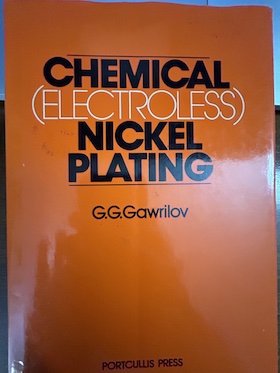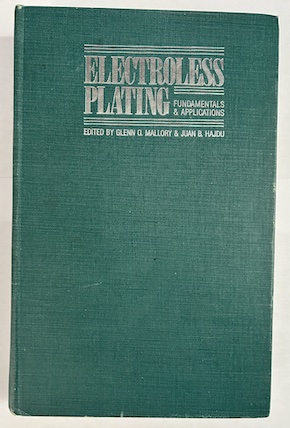
-----
How does Electroless Plating work?
Q. Hi, I am heydari from Iran. I'm studying about processing of electroless. If it is possible, please explain about this process.
Thank you.
University of technology of Isfahan- Isfahan iran
January 18, 2022
by G. G. Gawrilov

on eBay or Amazon
or AbeBooks
(affil link)
A. Hello Heydari. We appended your inquiry to an existing thread on the subject.
In the plating field "electroless plating" does not refer to all types of plating that are done without electricity; rather it is shorthand for "autocatalytic electroless plating" specifically.
In autocatalytic plating, reducing agents as well as metal ions are dissolved into the plating solution, so that plating will spontaneously occur on any catalytic surface. "Autocatalytic" means that the metal that is being plated out is itself a catalytic surface so plating will continue as long as the item is immersed in the solution.
Luck & Regards,

Ted Mooney, P.E. RET
Striving to live Aloha
finishing.com - Pine Beach, New Jersey
Ted is available for instant help
or longer-term assistance.
January 2022
⇩ Related postings, oldest first ⇩
Q. I would like to understand the theory of electroless nickel plating. What kind of reactions take place? A description similar to the one provided for electroplating will be great. Thanks.
Ella [surname deleted for privacy by Editor]student - Boulder, Colorado, USA
2003
A. Hi Ella. When people speak of "electroless nickel plating" they always actually mean "autocatalytic electroless nickel plating"; they never mean "replacement" or "immersion" plating, such as you see in science class when an iron nail is placed in copper sulphate
⇦ on
eBay or
Amazon [affil link] and it spontaneously becomes copper plated. Immersion/replacement can occur when you place a baser metal into a solution of a nobler metal; the nobler metal grabs electrons from the baser metal, causing the baser metal to ionize and dissolve into solution and the nobler metal to deposit. One of the limitations of replacement/immersion plating is that as soon as the base metal becomes plated with the noble metal there is nothing left to drive the reaction so the process stops after an extremely thin deposit.
Autocatalytic nickel plating processes contain dissolved nickel plus a strong reducing agent like sodium borohydride or sodium hypophosphite. When a catalytic metal surface like steel or palladium is immersed in the plating solution, that metal surface catalyzes the reduction of the nickel ions to nickel metal by the reducing agent. The power of the reducing agent is what powers the reduction.
One of the metal surfaces that comprises a catalyst is nickel itself (hence the name "autocatalytic"). Thus, even though the steel or palladium surface becomes fully covered with nickel metal, the reaction does not stop (like replacement/immersion plating processes do) because the newly deposited nickel metal also serves as a catalyst for the continuing reaction. The plating continues until the metal object is removed. The plating bath also contains stabilizers to slow down the deposition reaction and (hopefully) prevent the nickel values from spontaneously plating out. Even still, electroless nickel baths do sometimes "seed out".
Some metals like copper are not catalytic to this process, so you can't truly electroless nickel plate copper. However, all it takes is a tiny spark of rectifier power to the copper for a second to initiate electrolytic nickel plating, which will be immediately followed by electroless nickel plating.

Ted Mooney, P.E.
Striving to live Aloha
finishing.com - Pine Beach, New Jersey
Ted is available for instant help
or longer-term assistance.
2003
Q. Halo, my name is isaiah rotich. Please help, I have understood how electroless plating happens on a single metal like nickel on a substrate. But what about two elements like NiP (Nickel/Phosphorous) on a substrate?
THANKS
- KENYA NAIROBI
December 21, 2019
A. Hi Isiah. The simplistic explanation is that the nickel metal is reduced out of a solution to nickel ions, but to allow/cause that reduction you require a reducing agent which will itself become oxidized; and since the reducing agent is hypophosphite, that's where the phosphorous component of the alloy comes from.
But, as I say, that is simplistic. The first chapter of Mallory & Hajdu "Electroless Plating" consists of 57 pages of an attempt to explain the reaction, wherein they offer ever more complicated yet still unbalanced equations.
Your level of chemistry understanding may be deeper and more ambitious than mine ... I just settle for "the phosphorous portion comes from the hypophosphite" :-)
Regards,

Ted Mooney, P.E. RET
Striving to live Aloha
finishing.com - Pine Beach, New Jersey
Ted is available for instant help
or longer-term assistance.
Q. How can we do electroless on PBT plastic?
Frasat Ali- Pakistan Punjab Gujranwala
October 16, 2020
A. Hi Frasat. Please give us a starting point so we can say something beyond "you clean it, etch it, activate it, and plate it".
If you are a highly experienced plastic plating shop, thread 15914 "Problems electroplating polycarbonate, PBT, other plastics & blends" will give you some excellent hints about what is special about plating and electrolessly plating PBT as opposed to other plastics.
If your question represents just a vague "student question" sort of curiosity about how plating on plastic is done, searching the site will reveal dozens of threads on the subject; thread 10887 might be a good starting point.
But if you have no plating on plastic experience and you are contemplating electroless plating of PBT, you must find an experienced plating on plastics consultant or employee to get you started.
Please tell us your full situation and we can try to help! A general hint for getting good answers in this forum is that your question should be more words than you want the answer to be :-)
Good luck.
Luck & Regards,

Ted Mooney, P.E. RET
Striving to live Aloha
finishing.com - Pine Beach, New Jersey
Ted is available for instant help
or longer-term assistance.
October 2020
Q, A, or Comment on THIS thread -or- Start a NEW Thread
